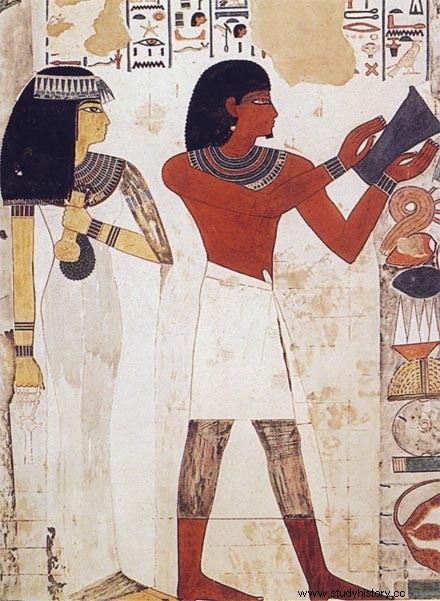Painting in Ancient Egypt was used to decorate burial chambers, temples and palaces, usually in fresco, and the theme varied between religious symbology and everyday life. A curiosity of these paintings is that the human figures were represented as young people, without wrinkles and beautiful. For what is this? For two main reasons:one vital and the other aesthetic. Whether it was stolen or posed, it was very difficult to find a "model" who had reached 40 and, therefore, the bodies had not deteriorated too much. And, above all, because the Egyptians, both men and women, were very flirtatious and vain.

After a good bath, don't be surprised that it was scented, they smeared their bodies with olive oil and an abrasive substance to exfoliate the skin. The ritual continued with a moisturizing cream based on honey or moringa oil, which also served to relieve sunburn and remove pregnancy stretch marks, an ointment based on incense or cinnamon as a deodorant, henna to color the hair , either their own or that of the wig, and a wax-based fixative that they left to dry in the sun to maintain the hairstyle. Perfumes were also common, depending on their preparation, the presentation format could be liquid, in oils and even solid. Dried flowers were allowed to macerate in odorless oils that 'stealed' the scent of the flowers, obtaining a scented oil or, if diluted, a liquid perfume. Another method of elaboration was to mix resins with dried flowers, aromatic spices or plants and heat them to obtain a scented paste that, before cooling, was shaped into a cone shape and placed on the head or shoulders. The heat of the day melted it and you were leaving an intoxicating trail or, perhaps, repulsive. For the most daring, because of how painful they were, there were 100% effective anti-aging treatments to eliminate wrinkles:they rubbed their skin with a mixture of calcite powder and natron (a black viscous substance with which they were mummified) that left the soft and rosy skin. The reality is that there was no mystery, because what was achieved was to leave your face raw.
And most importantly, black eyeshadow or kohl . And I say the most important, because it was not only a cosmetic, but it may have been one of the first ophthalmic preparations in history. The kohl It was a compound based on crushed galena mineral, mixed with soot for the poorest and with whatever the wealthy wanted, which was diluted with some oil or fat to fix it around the eyes. In addition to the aesthetic component, the kohl served to repel insects, reduce the reflection of the sun and help the eyelids in the mission of protecting the eyes by trapping sand particles.

Another characteristic of these paintings is that they had the so-called "Egyptian profile" or profile canon. These paintings lacked perspective:the size of the figures did not indicate that they were closer or further away. The size had to do with the importance of the figures they represented, the largest being those of the gods, then those of the pharaoh and so on, decreasing as the figures represented lower social classes. If the color of the skin was ocher or dark brown, it was indicated that it was a man and light brown if it was a woman. Furthermore, depending on the body parts, some are drawn from the front and others in profile:the head is shown in profile, albeit with a frontal view of the eyebrow and eye, the shoulders and torso frontally, while the hips and the extremities recover the profile. It is not necessary to think that the artist draws a whole, but parts of a whole and each of them is reflected with the view that he best described and the importance they have within the whole. It is like a graphic representation of what the Egyptians called Ba (his personality, the characteristic features of his being). The "important" part of the face is the nose, aquiline or flat, and the eyes, the look, and the "important" part of the body is the torso, where the heart is located, that's why they draw them from the front view.
Although those drawings lacked depth and volume (flat colors and without blurring), the reality is that they went beyond a simple drawing, they had more to do with the magical and divine world that enveloped the entire Egyptian society.
